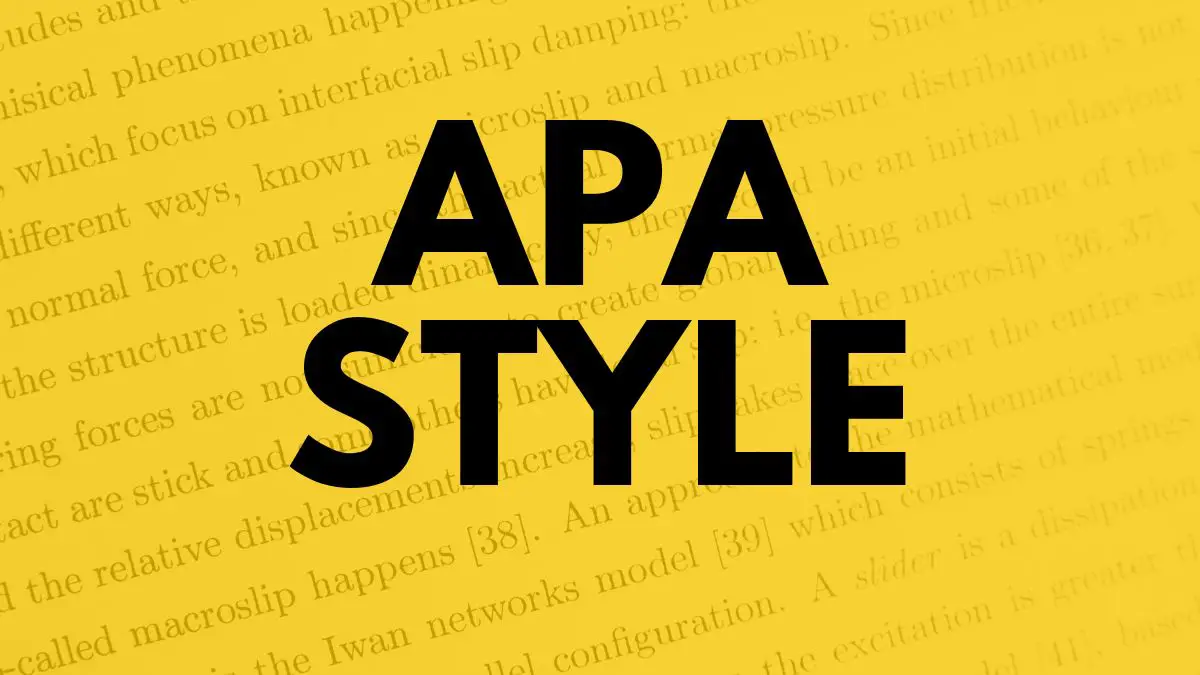Table of Contents
- Introduction
- What is APA Style Writing Format?
- Why Use APA Style?
- Understanding the Basic Components of APA Style
- How to Apply APA Style in Your Writing
- Common Mistakes in APA Style Writing Format
- Conclusion
Introduction
This write-up will introduce and explore the APA Style writing format. Whether you are a student just starting your academic journey or a seasoned researcher looking to brush up on the basics, this post will provide a helpful overview of the APA Style and how to apply it in your writing.
The APA Style writing format is the official format used by the American Psychological Association. It provides guidelines on how to structure and format academic papers and citations.
While it is most commonly used in the social sciences, the APA Style writing format can be applied to writing across all disciplines. The APA style is popular alongside other academic writing formats, such as the Chicago Manual of Style, MLA, and Harvard styles.

This article will equip beginners with the core knowledge to understand and use the APA Style. We will cover the key elements of APA formatting, when and why to use this style, common mistakes to avoid, and tips for seamlessly integrating APA Style into your work.
By the end of this post, you will have a solid foundation for applying proper APA Style in your academic writing. This will give your work more credibility, improve clarity, and demonstrate your attention to detail – all highly valued academic skills.
What is APA Style Writing Format?
The APA Style is a set of guidelines for writing and formatting papers in the social sciences. It was first developed in 1929 by a group of psychologists, anthropologists, and business managers who came together to establish standards for scientific communication.
Since then, the APA Style has become one of the most popular formats for writing academic papers, particularly in psychology, education, and the social sciences.
Several key elements comprise the APA Style formatting. These include:
- Title Page – Includes the paper’s title, author’s name, and institutional affiliation.
- Abstract – A summary of the paper, usually 150-250 words.
- Main Body – The bulk of the paper, including the method, results, and discussion sections.
- References – A list of all sources cited in the paper, formatted according to APA guidelines.
The APA Style also provides guidelines for formatting elements like headings, in-text citations, figures, and tables within the main body. For example, in-text citations usually follow the author-date format (e.g., Smith, 2019).
The goal of the APA Style writing format is to standardize scientific writing, making it more accessible, clear, and consistent for readers. It helps organize and structure papers, provides complete credit to sources used, and allows others to quickly follow and validate research methodology and findings.
While the APA Style originated in psychology, it is now widely used as the main style convention in many academic disciplines, especially the social and behavioral sciences. Understanding the basics of APA Style formatting is critical for any student or researcher writing a paper for publication in these fields.
Why Use APA Style?
Using the APA Style in academic writing and research papers is crucial for several reasons. First, it provides credibility to one’s work. A paper following the standard formatting and citation guidelines of APA Style shows the writer’s commitment to professionalism and attention to detail. The consistent format lets readers quickly navigate the paper and find the necessary information. This builds trust between the writer and the reader.
Additionally, using the APA Style ensures consistency across academic publications. Journal publishing, textbooks, and other social sciences and psychology materials universally utilize the APA Style.
By adopting this standard style in your writing, you align yourself with the accepted practices of your field. This consistency allows for efficient communication of ideas across different works. Researchers can easily find and cite your paper if it follows the expected APA Style guidelines.
Furthermore, the APA Style provides clear guidelines for referencing, citations, tables, figures, and other common elements in academic publishing. A reputable journal will use a standard writing format, and APA Style is a popular option.
Writers can follow the APA Style manual specifications for formatting these items correctly. Doing so demonstrates their ability to produce polished, professional papers without plagiarism. Readers can seamlessly check the citations and references to verify the research process.
Overall, using the APA Style gives both credibility and consistency to academic work. It displays a commitment to professional standards, allows for efficient navigation of papers, and facilitates clear communication across publications. By applying the APA Style correctly, writers and researchers show respect for their work and their audience.
Understanding the Basic Components of APA Style
Using proper APA Style writing format is crucial for presenting your academic work in a clear, consistent way. Here are some of the essential components to understand:
APA Style Formatting
APA Style requires specific formatting for your paper layout. This includes:
- 1-inch margins on all sides.
- Double spacing throughout the paper.
- Page numbers in the top right corner.
- 12 pt Times New Roman font is recommended in APA Style. But if you prefer other options, go for fonts that are easy to read.
- Title page with title, author name, and affiliation.
Following these basic formatting guidelines ensures your paper looks polished and professionally done.
APA Style In-Text Citations
Whenever you reference a source in the body of your paper, you must include an in-text citation. This briefly identifies the source for readers. In APA Style writing format, in-text citations include the author’s last name and year of publication enclosed in parentheses, e.g., (Jones, 2019).
Be sure to properly cite every fact, quote, or idea that is not yours. This gives credit to other researchers and allows readers to verify your information.
APA Style Reference List
At the end of your paper, you must include a reference list titled “References.” This lists all the sources cited in your paper and allows readers to find them easily.
Each reference should be formatted with the author’s name, publication year, title, publisher location, and other vital details. Make sure references are ordered alphabetically by the author’s last name.
Tips for Implementation
Here are some tips for effectively using the APA Style writing format:
- Use citation generators to create citations easily.
- Ask your professor or a librarian if you need clarification.
- Read the latest APA Style manual for guidance.
- Use the APA Style checklist before submitting your paper.
- Be consistent in formatting from your first to last page.
With practice, using the proper APA style will become second nature. Focus on accuracy, and you’ll be citing sources like a pro.
How to Apply APA Style in Your Writing
Applying the APA Style in your academic writing can initially seem daunting, but following a few key steps will make the process much easier.
Write Your Abstract
The abstract is a summary that comes after the title page. It should be 150-250 words and touch on key points like the research topic, methods, results, and conclusions. Writing it after you finish the paper will help ensure it accurately reflects the contents.
In-Text Citations
Each time you reference a source in the text, include an in-text citation in parentheses with the author’s last name and year of publication. For a direct quote, add the page number. For example:
(James, 2022) or (James, 2022, p. 35).
This allows readers to find the complete source in your reference list quickly.
Reference List
The reference list appears at the end of your paper. It provides the full publication details of every source cited. List the sources alphabetically by the author’s last name. Apply hanging indents for each entry.
Following the APA Style format for the reference list ensures readers can locate the sources if needed.
With practice, applying the APA Style will become second nature. Refer to style guides or academic samples as needed when getting started. Proper use of APA Style demonstrates your credibility as a writer.
Common Mistakes in APA Style Writing Format
When first learning the APA Style, it’s common to make some mistakes. However, knowing the most frequent errors can help you avoid them in your writing (note that guidelines by APA Style are recommended for optimal experience; it’s not compulsory per se).
Formatting Mistakes
Some of the most common formatting mistakes include:
- Not having 1-inch margins on all sides of the page.
- Using incorrect font or size (the APA Style recommends Times New Roman 12pt font).
- Forgetting to double-space the entire document.
- Neglecting to include a page header with the page number and running head
Carefully proofreading your paper’s formatting is crucial to spotting these errors.
Citation and Reference List Errors
Proper citation and referencing in APA Style also often trips up beginners. Some mistakes to avoid include:
- Failing to cite paraphrased or summarized ideas from another source
- Citing sources in the text that do not have complete reference list entries
- Making mistakes in reference list entries, like omitting the issue number for a journal article
- Incorrectly formatting in-text citations (e.g., failing to use ampersands between multiple authors’ names)
Double-checking that every cited source has a corresponding reference, and vice versa, is key to avoiding these errors.
The Importance of Editing
Finally, it’s vital to carefully edit and proofread your entire paper before submission, not just piecemeal sections. This allows you to catch any formatting inconsistencies or citation errors you may have missed the first time around. Having a friend or colleague provide a second set of eyes can also help spot mistakes.
Remember, with practice and vigilance, you can comply with the APA Style and avoid common mistakes. Mastering the APA Style does take time, but you’ll get there!
Conclusion
By now, you should have a solid understanding of the APA Style writing format, why it’s essential for academic writing, and how to apply it in your work.
To quickly recap, the APA Style provides guidelines for formatting your paper, citing sources, and structuring your references. Adhering to these standards lends credibility to your work and ensures consistency across academic publications. While it may seem tedious initially, practicing APA Style writing format will soon become second nature.
As you embark on your academic writing journey, implement the tips provided throughout this write-up. Every detail matters in APA Style, from setting up your title page to proofreading your references. Avoid common beginner mistakes by double-checking your work. With time and practice, you’ll be citing sources like a pro.


8 thoughts on “The APA Style Writing Format”